| Model | 787-8 | 787-9 |
|---|---|---|
| Cockpit crew | Two | |
| Seating, typical | 210-250 224 (3-class) |
250-290 280 (3-class) |
| Length | 186 ft (56.7 m) | 206 ft (62.8 m) |
| Wingspan | 197 ft 0 in (60.0 m) | 197 ft 0 in (60.0 m) |
| Wing area | 3,501 sq ft (325 m2) | |
| Wing sweepback | 32.2 degrees | |
| Height | 55 ft 6 in (16.9 m) | |
| Fuselage dimensions | Width: 18 ft 11 in (5.77 m) / Height: 19 ft 7 in (5.97 m) | |
| Maximum cabin width | 18 ft (5.49 m) | |
| Cargo capacity | 4,822 cu ft (137 m3) 28× LD3 or 9x (88x125) pallets or 8x (96x125) pallets + 2x LD3 |
6,086 cu ft (172 m3) 36× LD3 or 11x (88x125) pallets or 11x (96x125) pallets |
| Maximum takeoff weight | 502,500 lb (228,000 kg) | 545,000 lb (247,000 kg) |
| Maximum landing weight | 380,000 lb (172,000 kg) | 425,000 lb (193,000 kg) |
| Operating empty weight | 242,000 lb (110,000 kg) | 254,000 lb (115,000 kg) |
| Cruising speed | Mach 0.85 (567 mph, 490 knots, 913 km/h at 35,000 ft/10,700 m) | |
| Maximum speed | Mach 0.89 (593 mph, 515 knots, 954 km/h at 35,000 ft/10,700 m) | |
| Range, fully loaded | 7,650–8,200 nmi (14,200–15,200 km; 8,800–9,440 mi) | 8,000–8,500 nmi (14,800–15,700 km; 9,210–9,780 mi) |
| Maximum fuel capacity | 33,528 US gal (126,920 L) | 33,428 US gal (126,540 L) |
| Service ceiling | 43,000 ft (13,100 m) | |
| Engines (×2) | General Electric GEnx or Rolls-Royce Trent 1000 | |
| Thrust (×2) | 64,000 lbf (280 kN) | 71,000 lbf (320 kN) |
Boeing B-787 Dreamliner
The Boeing 787 Dreamliner is a long-range, mid-size, wide-body, twin-engine jet airliner developed by Boeing Commercial Airplanes. It seats 210 to 330 passengers, depending on the variant. Boeing states that it is the company's most fuel-efficient airliner and the world's first major airliner to use composite materials for most of its construction. The 787 consumes 20% less fuel than the similarly-sized Boeing 767. The aircraft's initial designation 7E7 was changed to 787 in January 2005. By February 2011, 847 Boeing 787s had been ordered by 56 customers. It is being assembled at the Boeing Everett Factory in Everett, Washington. Both sites will deliver 787s to airline customers. The airliner's maiden flight took place on December 15, 2009, and it is currently undergoing flight testing with a goal of receiving certification in mid-2011 and entering service in 2011.
Development
During the late 1990s, Boeing began considering replacement aircraft programs as sales for the 767 and Boeing 747-400 slowed. The global airline market was upended by the September 11, 2001 attacks and increased petroleum prices, making airlines more interested in efficiency than speed. The worst-affected airlines, those in the United States, had been considered the most likely customers of the Sonic Cruiser, and thus Boeing officially canceled the Sonic Cruiser on December 20, 2002.
Design effort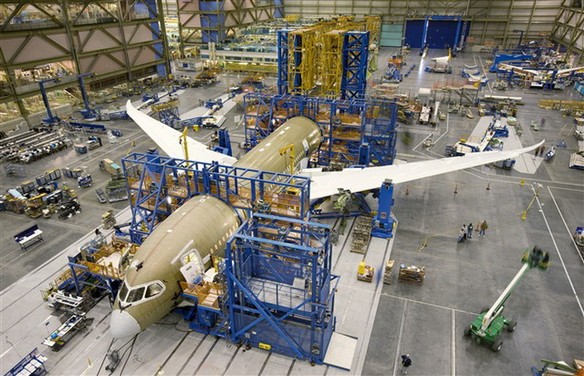 On April 26, 2004, Japanese airline All Nippon Airways became the launch customer for the 7E7 Dreamliner, by announcing a firm order for 50 aircraft with deliveries to begin in late 2008. All Nippon Airways's order was initially specified as 30 787-3, 290-330 seat, one-class domestic aircraft, and 20 787-8, long-haul, 210-250 seat, two-class aircraft for regional international routes such as Tokyo Narita-Beijing. The 787 was designed to become the first production composite airliner, with the fuselage assembled in one-piece composite barrel sections instead of the multiple aluminum sheets and some 50,000 fasteners used on existing aircraft. Boeing selected two new engine types to power the 787, the General Electric GEnx and Rolls-Royce Trent 1000. During the design phase, the 787 underwent extensive wind tunnel testing at Boeing's Transonic Wind Tunnel, QinetiQ's five-meter wind tunnel at Farnborough, UK, and NASA Ames Research Center's wind tunnel, as well as at the French aerodynamics research agency, ONERA. By the end of 2004, customer-announced orders and commitments for the 787 reached 237 aircraft. Boeing initially priced the 787-8 variant at US$120 million, a low figure that surprised the industry. After stiff competition, Boeing announced on December 16, 2003, that the 787 would be assembled in its factory in Everett, Washington. Boeing assigned its global subcontractors to do more assembly themselves and deliver completed subassemblies to Boeing for final assembly. Subcontracted assemblies included wing manufacture (Mitsubishi Heavy Industries, Japan, central wing box) horizontal stabilizers (Alenia Aeronautica, Italy; Korea Aerospace Industries, South Korea); fuselage sections (Global Aeronautica, Italy; Boeing, North Charleston, USA; Kawasaki Heavy Industries, Japan; Spirit AeroSystems, Wichita, USA; Korean Air, South Korea); passenger doors (Latécoère, France); cargo doors, access doors, and crew escape door (Saab, Sweden); floor beams (TAL Manufacturing Solutions Limited, India); wiring (Labinal, France); wing-tips, flap support fairings, wheel well bulkhead, and longerons (Korean Air, South Korea); landing gear (Messier-Dowty, France);and power distribution and management systems, air conditioning packs (Hamilton Sundstrand, Connecticut, USA).To speed delivery of the 787's major components, Boeing modified several used 747-400s into 747 Dreamlifters to transport 787 wings, fuselage sections, and other smaller parts. On 26 April 2006, Japanese manufacturer Toray Industries and Boeing announced a production agreement involving US$6 billion worth of carbon fiber, extending a 2004 contract and aimed at easing production concerns.
On April 26, 2004, Japanese airline All Nippon Airways became the launch customer for the 7E7 Dreamliner, by announcing a firm order for 50 aircraft with deliveries to begin in late 2008. All Nippon Airways's order was initially specified as 30 787-3, 290-330 seat, one-class domestic aircraft, and 20 787-8, long-haul, 210-250 seat, two-class aircraft for regional international routes such as Tokyo Narita-Beijing. The 787 was designed to become the first production composite airliner, with the fuselage assembled in one-piece composite barrel sections instead of the multiple aluminum sheets and some 50,000 fasteners used on existing aircraft. Boeing selected two new engine types to power the 787, the General Electric GEnx and Rolls-Royce Trent 1000. During the design phase, the 787 underwent extensive wind tunnel testing at Boeing's Transonic Wind Tunnel, QinetiQ's five-meter wind tunnel at Farnborough, UK, and NASA Ames Research Center's wind tunnel, as well as at the French aerodynamics research agency, ONERA. By the end of 2004, customer-announced orders and commitments for the 787 reached 237 aircraft. Boeing initially priced the 787-8 variant at US$120 million, a low figure that surprised the industry. After stiff competition, Boeing announced on December 16, 2003, that the 787 would be assembled in its factory in Everett, Washington. Boeing assigned its global subcontractors to do more assembly themselves and deliver completed subassemblies to Boeing for final assembly. Subcontracted assemblies included wing manufacture (Mitsubishi Heavy Industries, Japan, central wing box) horizontal stabilizers (Alenia Aeronautica, Italy; Korea Aerospace Industries, South Korea); fuselage sections (Global Aeronautica, Italy; Boeing, North Charleston, USA; Kawasaki Heavy Industries, Japan; Spirit AeroSystems, Wichita, USA; Korean Air, South Korea); passenger doors (Latécoère, France); cargo doors, access doors, and crew escape door (Saab, Sweden); floor beams (TAL Manufacturing Solutions Limited, India); wiring (Labinal, France); wing-tips, flap support fairings, wheel well bulkhead, and longerons (Korean Air, South Korea); landing gear (Messier-Dowty, France);and power distribution and management systems, air conditioning packs (Hamilton Sundstrand, Connecticut, USA).To speed delivery of the 787's major components, Boeing modified several used 747-400s into 747 Dreamlifters to transport 787 wings, fuselage sections, and other smaller parts. On 26 April 2006, Japanese manufacturer Toray Industries and Boeing announced a production agreement involving US$6 billion worth of carbon fiber, extending a 2004 contract and aimed at easing production concerns.
Production and delivery delays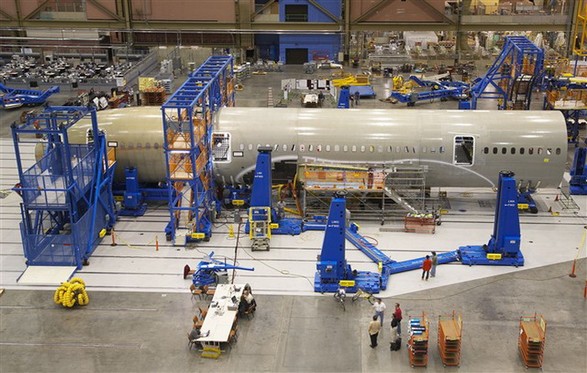 Boeing had originally planned for a first flight by the end of August 2007 and premiered the first 787 at a rollout ceremony on July 8, 2007, which matches the aircraft's designation in the US-style month-day-year format (7/8/07). However, the aircraft's major systems had not been installed at that time, and many parts were attached with temporary non-aerospace fasteners requiring their later replacement with flight fasteners. On September 5, Boeing announced a three-month delay, blaming a shortage of fasteners as well as incomplete software. On January 16, 2008, Boeing announced a third three-month delay to the first flight of the 787, citing insufficient progress on "traveled work".On March 28, 2008, in an effort to gain more control over the supply chain, Boeing announced that it planned to buy Vought Aircraft Industries' interest in Global Aeronautica; the company later agreed to also purchase Vought's North Charleston, S.C. factory.
Boeing had originally planned for a first flight by the end of August 2007 and premiered the first 787 at a rollout ceremony on July 8, 2007, which matches the aircraft's designation in the US-style month-day-year format (7/8/07). However, the aircraft's major systems had not been installed at that time, and many parts were attached with temporary non-aerospace fasteners requiring their later replacement with flight fasteners. On September 5, Boeing announced a three-month delay, blaming a shortage of fasteners as well as incomplete software. On January 16, 2008, Boeing announced a third three-month delay to the first flight of the 787, citing insufficient progress on "traveled work".On March 28, 2008, in an effort to gain more control over the supply chain, Boeing announced that it planned to buy Vought Aircraft Industries' interest in Global Aeronautica; the company later agreed to also purchase Vought's North Charleston, S.C. factory.
On April 9, 2008, Boeing officially announced a fourth delay, shifting the maiden flight to the fourth quarter of 2008, and delaying initial deliveries by around 15 months to the third quarter of 2009. The 787-9 variant was postponed to 2012 and the 787-3 variant was to follow with no firm delivery date. On November 4, 2008, the company announced a fifth delay due to incorrect fastener installation and the Boeing machinists strike, stating that the first test flight would not occur in the fourth quarter of 2008. After assessing the 787 program schedule with its suppliers, Boeing confirmed on December 11, 2008 that the first flight would be delayed until the second quarter of 2009.
On June 15, 2009, during the Paris Air Show, Boeing said that the 787 would make its first flight within two weeks. However, on June 23, 2009, Boeing announced that the first flight is postponed "due to a need to reinforce an area within the side-of-body section of the aircraft". Boeing provided an updated 787 schedule on August 27, 2009, with the first flight planned to occur by the end of 2009 and deliveries to begin at the end of 2010. Boeing announced on July 15, 2010, that the first delivery to launch customer All Nippon Airways could slip into 2011, and on August 27, 2010 it confirmed that the first delivery would be delayed until early 2011. Boeing and Rolls-Royce state a lack of Trent 1000 engines as the cause, following shutdown of Rolls-Royce's test facility after a blowout in a Trent 1000 during ground testing on August 2. In January 2011, Boeing announced that the first 787 delivery was rescheduled to the third quarter of 2011 due to software and electrical updates following the in-flight fire in November 2010.
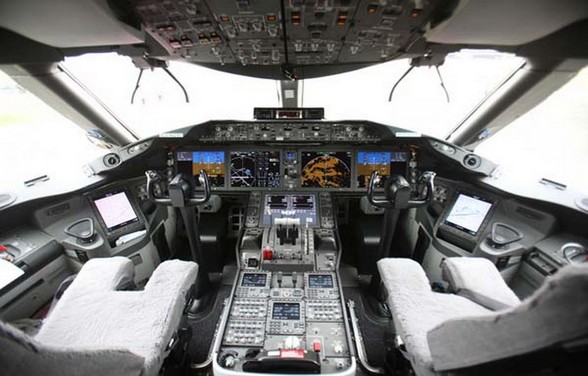 Pre-flight ground testing
Pre-flight ground testing
As Boeing worked with its suppliers on early 787 production, the aircraft design had proceeded through a series of test goals. On August 23, 2007, a crash test involving a vertical drop of a partial composite fuselage section from about 15 ft (4.6 m) onto a 1 in (25 mm)-thick steel plate occurred in Mesa, Arizona; the results matched what Boeing's engineers had predicted, allowing modeling of various crash scenarios using computational analysis instead of further physical tests.
On June 20, 2008, the 787 team achieved "Power On" of the first aircraft, powering and testing the aircraft's electrical supply and distribution systems. when flying at maximum cruising altitude). On May 3, 2009, the first test 787 was moved to the flight line following extensive factory-testing, including landing gear swings, systems integration verification, and a total run-through of the first flight. Boeing spent most of May 2009 conducting tests on the first 787 in preparation for the first flight. On March 28, 2010, the 787 completed the ultimate wing load test, which requires that the wings of a fully assembled aircraft be loaded to 150% of design limit load and held for 3 seconds. Unlike past aircraft however, the wings were not tested to failure. On April 7, Boeing announced that analysis of the data showed the test was a success. On December 12, 2009, the first 787 completed high speed taxi tests, the last major step before flight.
Flight test program
On December 15, 2009, Boeing conducted the Dreamliner's maiden flight with the first 787-8, originating from Snohomish County Airport in Everett, Washington at 10:27 am PST, and landing at Boeing Field in King County, Washington at 1:35 pm PST. Boeing's schedule called for a 9-month flight test campaign (later revised to 8.5 months). The company's previous major aircraft, the 777, took 11 months with nine aircraft, partly to demonstrate 180-min ETOPS, one of its main features.
The 787 flight test program is composed of 6 aircraft, ZA001 through ZA006, four with Rolls-Royce Trent 1000 engines and two with GE GEnx-1B64 engines. The second 787, ZA002 in All Nippon Airways livery, flew to Boeing Field on December 22, 2009 to join the flight test program; the third 787, ZA004 joined the test fleet with its first flight on February 24, 2010, followed by ZA003 on March 14, 2010.
On March 24, 2010, testing for flutter and ground effects was completed, clearing the aircraft to fly its entire flight envelope.
Dreamliner ZA005, the fifth 787 and the first with General Electric GEnx engines began ground engine tests in May 2010. ZA005 made its first flight on June 16, 2010 and joined the flight test program. In September 2010, it was reported that a further two 787s might join the test fleet, making a total of eight flight test aircraft. On October 4, 2010, the sixth 787, ZA006 joined the test program with its first flight.
On November 9, 2010, Boeing 787, ZA002 made an emergency landing after smoke and flames were detected in the main cabin during a test flight over Texas. A Boeing spokeswoman said the airliner landed safely and the crew was evacuated after landing at the Laredo International Airport, Texas. Ground testing has been performed instead. On November 22, 2010, Boeing announced that the in-flight fire can be primarily attributed to foreign object debris (FOD) that was present in the electrical bay. After electrical system and software changes, the 787 resumed company flight testing on December 23, 2010.
On February 24, 2011, Boeing announced that the 787 had completed 80% of the test conditions for Rolls-Royce Trent 1000 engine and 60% of the conditions for the General Electric GEnx-1B engine. As of February 26, 2011, the seven 787 test aircraft have flown 2,974 hours in 1,008 flights combined. 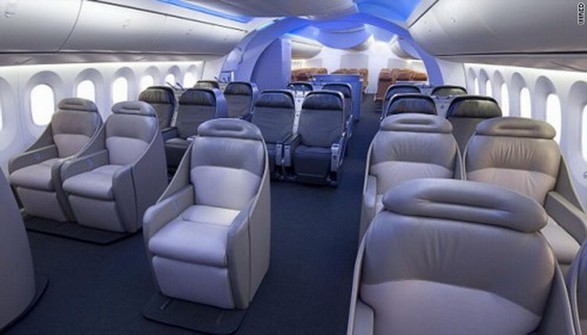 Design
Design
External features include raked wingtips and engine nacelles with noise-reducing serrated edges. The two different engine models compatible with the 787 use a standard electrical interface to allow an aircraft to be fitted with either Rolls-Royce or General Electric engines. This aims to save time and cost when changing engine types; while previous aircraft can have engines changed to those of a different manufacturer, the high cost and time required makes it rare. In 2006, Boeing addressed reports of an extended change period by stating that the 787 engine swap was intended to take 24 hours; engine interchangeability, it is reported, makes the 787 a more flexible asset to airlines, allowing them to change easily from one manufacturer's engine to the other if required.
Airframe
The 787 features lighter-weight construction. Its materials (by weight) are: 50% composite, 20% aluminum, 15% titanium, 10% steel, 5% other.; Carbon fiber composites have a higher strength-to-weight ratio than traditional aircraft materials, and help make the 787 a lighter aircraft. Composites are used on fuselage, wings, tail, doors, and interior. Boeing had built and tested the first commercial aircraft composite section while examining the Sonic Cruiser concept nearly five years before; the Bell Boeing V-22 Osprey military transport uses over 50% composites, and the C-17 has over 16,000 lb (7,300 kg) of structural composites.
In 2006, Boeing launched the 787 GoldCare program. Boeing is also designing and testing composite hardware so inspections are mainly visual.
Flight systems
On the 787, Honeywell and Rockwell-Collins provide flight control, guidance, and other avionics systems, including standard dual head up guidance systems, while Thales supplies the integrated standby flight display and electrical power conversion system. A version of Ethernet (Avionics Full-Duplex Switched Ethernet (AFDX) / ARINC 664) will be used to transmit data between the flight deck and aircraft systems.
The flight deck features LCD multi-function displays, all of which will use an industry standard GUI widget toolkit (Cockpit Display System Interfaces to User Systems / ARINC 661).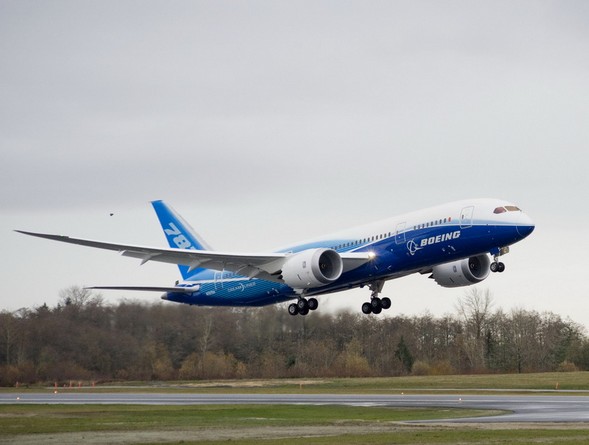 Like other Boeing airliners, the 787 will use a yoke instead of a side-stick. engine starters or brakes). The 787's engines use all-electrical bleedless systems, eliminating the superheated air conduits normally used for aircraft power, de-icing, and other functions. Another new system is a wing ice protection system that uses electro-thermal heater mats on the wing slats instead of hot bleed air that has been traditionally used.
Like other Boeing airliners, the 787 will use a yoke instead of a side-stick. engine starters or brakes). The 787's engines use all-electrical bleedless systems, eliminating the superheated air conduits normally used for aircraft power, de-icing, and other functions. Another new system is a wing ice protection system that uses electro-thermal heater mats on the wing slats instead of hot bleed air that has been traditionally used.
Boeing, as part of its "Quiet Technology Demonstrator 2" project, is experimenting with several engine noise-reducing technologies for the 787. Boeing expects these developments to make the 787 significantly quieter both inside and out.
The 787-8 is designed to seat 234 passengers in a three-class setup, 240 in two-class domestic configuration, and 296 passengers in a high-density economy arrangement. For economy class in 3-2-3 or 2-4-2 arrangements, seat-bottom widths will be 18.5 in (47 cm), comparable to that found on the Boeing 777, and recommended by detailed passenger ergonomics studies; for 3-3-3 and the 2-5-2 maximum passenger density layout, seat widths would be 17.18 in (43.55 cm), with most airlines expected to select the 3-3-3 maximum passenger density configuration. Boeing engineers designed the 787 interior to better accommodate persons with mobility, sensory, and cognitive disabilities. According to Boeing, in a joint study with Oklahoma State University, this will significantly improve passenger comfort. A higher cabin pressure is possible in part because of better properties of composite materials. Cabin air is provided by electrically driven compressors using no engine-bleed air. An advanced cabin air-conditioning system provides better air quality: Ozone is removed from outside air; HEPA filters remove bacteria, viruses, and fungi; and a gaseous filtration system removes odors, irritants, and gaseous contaminants.
Technical concerns
Composites
As the aircraft reaches altitude, the moisture expands, and may cause delamination of the composite materials, and structural weakness over time. Boeing has dismissed criticisms of its fuselage materials, insisting that composites have been used on wings and other passenger aircraft parts for many years, and they have not been an issue. Boeing has stated that the 787's lightning protection will meet FAA requirements, and FAA management was planning to adjust some requirements, which will help the 787 show compliance.
Weight issues
The seventh and subsequent aircraft will be the first optimized 787s and are expected to meet all goals, with Boeing working on weight reductions. Boeing has redesigned some parts and made more use of titanium. Substantial redesign work is expected to correct this, which will complicate increases in production rates; Boeing stated the early 787-8s will have a range of almost 8,000 nmi (14,800 km). Boeing expects to have the weight issues addressed by the 21st production model.
Computer networks
The computer network in the passenger compartment, designed to give passengers in-flight internet access, is connected to the airplane's control, navigation, and communication systems. As part of certification, Boeing plans to demonstrate to the FAA that these provisions are acceptable.
Variants
Boeing has offered three variants of the 787 from the program launch in 2004.
The 787-8 is scheduled to enter service in 2011; the 787-9 is to enter service in 2013.
787-8
The 787-8 seats 210 passengers in a three-class configuration. Boeing is targeting the 787-8 to replace the 767-200ER and 767-300ER, as well as expand into new non-stop markets where larger planes would not be economically viable. Boeing is targeting the 787-9 to compete with both passenger variants of the Airbus A330 and to replace their own 767-400ER. The design differences meant higher weight and resulted in a slightly shorter range than the 787-8. It will now have a longer range and a higher MTOW than the other two variants.
Other variants
787-3
This variant was designed to be a 290-seat (two-class) short-range version of the 787 targeted at high-density flights, with a range of 2,500 to 3,050 nautical miles (4,650 to 5,650 km) when fully loaded. It was designed to replace the Airbus A300/A310 and Boeing 757-300/767-200 on regional routes from airports with restricted gate spacing. (Actual range is based on remaining available weight for fuel after the aircraft empty weight and payload are subtracted from the MTOW.)
Boeing also believed legacy carriers could have used this variant to compete with low-cost airlines by running twice the capacity of a single-aisle craft for less than twice its operating cost (fuel, landing fees, maintenance, number of flight crew, airspace fees, parking fees, gate fees, etc.).
Boeing has stated that it is likely to develop another version, the longer 787-10, with seating capacity between 290 and 310. Boeing was having discussions with potential customers about the 787-10 in 2006 and 2007. The 787-10 has remained under consideration by Boeing.
Boeing is reported to be also considering a 787 variant as a candidate to replace the 747-based VC-25 as Air Force One.

